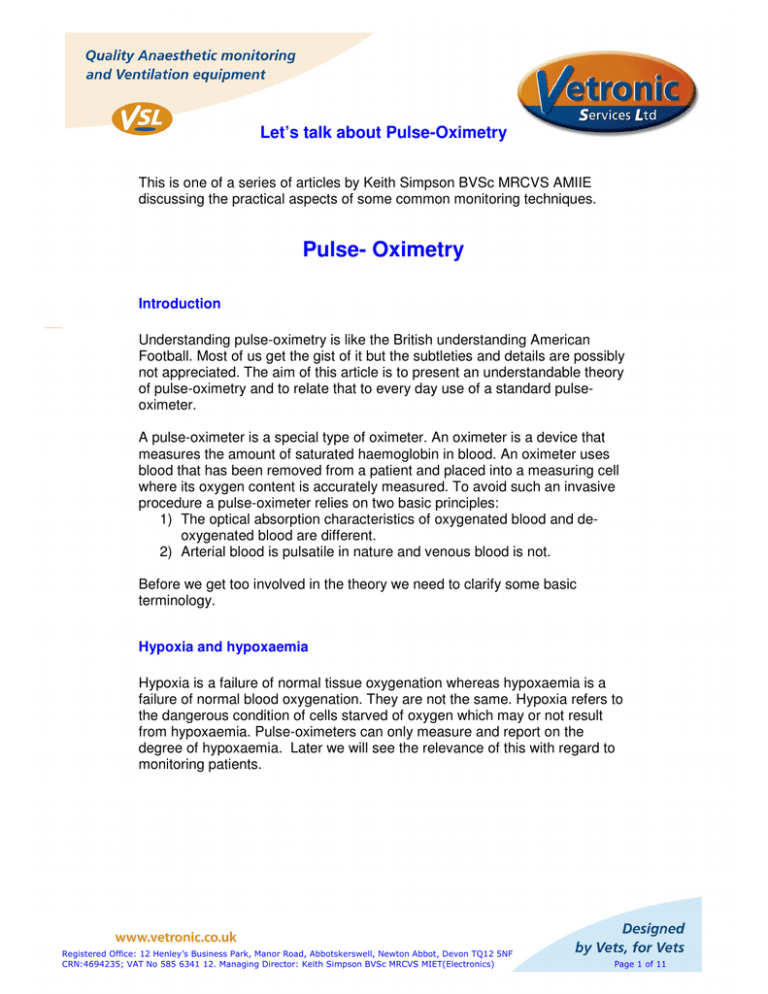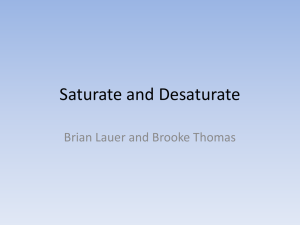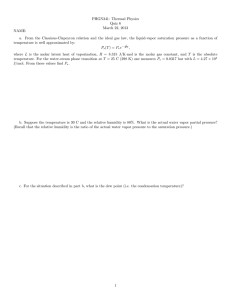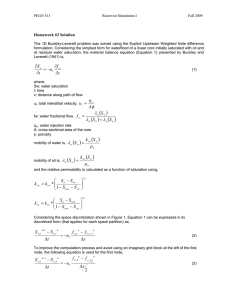Let`s talk about Pulse-Oximetry
advertisement

Let’s talk about Pulse-Oximetry This is one of a series of articles by Keith Simpson BVSc MRCVS AMIIE discussing the practical aspects of some common monitoring techniques. Pulse- Oximetry Introduction Understanding pulse-oximetry is like the British understanding American Football. Most of us get the gist of it but the subtleties and details are possibly not appreciated. The aim of this article is to present an understandable theory of pulse-oximetry and to relate that to every day use of a standard pulseoximeter. A pulse-oximeter is a special type of oximeter. An oximeter is a device that measures the amount of saturated haemoglobin in blood. An oximeter uses blood that has been removed from a patient and placed into a measuring cell where its oxygen content is accurately measured. To avoid such an invasive procedure a pulse-oximeter relies on two basic principles: 1) The optical absorption characteristics of oxygenated blood and deoxygenated blood are different. 2) Arterial blood is pulsatile in nature and venous blood is not. Before we get too involved in the theory we need to clarify some basic terminology. Hypoxia and hypoxaemia Hypoxia is a failure of normal tissue oxygenation whereas hypoxaemia is a failure of normal blood oxygenation. They are not the same. Hypoxia refers to the dangerous condition of cells starved of oxygen which may or not result from hypoxaemia. Pulse-oximeters can only measure and report on the degree of hypoxaemia. Later we will see the relevance of this with regard to monitoring patients. Registered Office: 12 Henley’s Business Park, Manor Road, Abbotskerswell, Newton Abbot, Devon TQ12 5NF CRN:4694235; VAT No 585 6341 12. Managing Director: Keith Simpson BVSc MRCVS MIET(Electronics) Page 1 of 11 SpO2 and SaO2 You may see on different pulse-oximeters the terms SaO2 and SpO2 and often these are used interchangeably. They are not the same thing. SaO2 refers to the oxygen saturation of arterial blood as measured by a COoximeter and SpO2 refers to the oxygen saturation of arterial blood as measured by a pulse-oximeter. Why the difference? As you may recall from your physiology there is more than one form of haemoglobin. Typically we all have oxyhaemoglobin, methaemoglobin, carboxyhaemoglobin, sulfhaemoglobin and carboxysulfhaemoglobin. Admittedly oxyhaemoglobin predominates but the others, the so-called dysfunctional haemoglobins are always there. A typical two-wavelength (we’ll come on to that later) pulseoximeter cannot distinguish between oxyhaemoglobin and the dysfunctional haemoglobins ( and in some instances cannot measure them). Both absorb light of both wavelengths and both are found in arterial blood. To compensate for this, most manufacturers of pulse-oximeters assume a level of around 2% for the dysfunctional haemoglobins and automatically adjust for this in the calculated value produced by the pulse-oximeter. In this way they can be used to display either an SpO2 reading or an SaO2 reading. Only a true COoximeter can determine an accurate value for SaO2. Thus an SpO2/SaO2 reading on a pulse-oximeter will always be an estimate of the value although it may follow it very closely. You may also see texts talking about fractional versus functional haemoglobin saturation measurements. This is just another way of describing the situation of SpO2 versus SaO2 readings as described above. SaO2 is a true fractional oxygen saturation measurement where SaO2 = HbO2 HbO2 + Hb +COHb + Methb + SfHb + COSfhb SpO2 is functional oxygen saturation measurement where SpO2 = HbO2 Hb + HbO2 What this means is that in the presence of these dysfunctional haemoglobins the SpO2 reading is incorrect and tends to over-estimate the value. What is the clinical significance of this? We can probably discount the sulfhaemoglobins and methaemoglobins as being quite rare in our patients. The predominant dysfunctional haemoglobin is carboxyhaemoglobin. In humans the level of carboxyhaemoglobin found in urban dwellers is around 13 % of the total haemoglobin, typically 2%. In moderate to heavy smokers this can reach 15% or more, which broadly would mean that a patient with 85% fractional saturation would appear to be nearly 100% saturated when Registered Office: 12 Henley’s Business Park, Manor Road, Abbotskerswell, Newton Abbot, Devon TQ12 5NF CRN:4694235; VAT No 585 6341 12. Managing Director: Keith Simpson BVSc MRCVS MIET(Electronics) Page 2 of 11 measured by a pulse-oximeter. I have seen no literature detailing the carboxyhaemoglobin levels of animals resident in a house with a heavy smoker but it would seem reasonable to assume that these animals would have carboxyhaemoglobin levels in excess of normal urban dwellers and could be as high as 5%. We need to bear this in mind when the dog that smells like an ashtray has a pulse-ox reading of 94% - it could truly be nearer 89%. Partial pressure Why is everyone always talking about partial pressures and what are they anyway? A partial pressure is just a way of describing the “concentration” of a gas in some medium, either a gas or a liquid. If we say that the partial pressure of carbon dioxide in blood is 50mmHg (millimetres of mercury) then what we are saying is that the amount of carbon dioxide in the blood is the result of that blood being in equilibrium with gaseous carbon dioxide at a pressure of 50mmHg. We don’t actually measure what is in the blood, we measure the conditions needed to keep it there. Since body temperature is relatively constant this is a valid means of measurement. The oxyhaemoglobin dissociation curve This dissociation curve depicts the relationship between the partial pressure of oxygen in the blood and the percentage of oxygen. As an explanation of the above the oxygen in this graph is shown as having a partial pressure of 160mmHg when blood is 100% saturated. Air is 21% oxygen and atmospheric pressure is 760mmHg. Therefore the partial pressure of oxygen is 21/100 X 760 = 160mmHg Registered Office: 12 Henley’s Business Park, Manor Road, Abbotskerswell, Newton Abbot, Devon TQ12 5NF CRN:4694235; VAT No 585 6341 12. Managing Director: Keith Simpson BVSc MRCVS MIET(Electronics) Page 3 of 11 The position of the curve relative to the left margin can shift with varying physiological influences. This is what is referred to as either a left shift or a right shift. If the curve shifts to the left i.e. towards the left margin you can see that haemoglobin is more easily saturated. For example the saturation of the solid curve at 40mmHg oxygen partial pressure is 80% but on the dotted curve it is 90% due to the left shift. Therefore anything that causes a left shift will tend to improve the binding of oxygen. Things that cause left shifts are: a rise in pH, a fall in PCO2 and a fall in temperature. The simplicity of this curve is sometimes misleading since it does not show the effect on the oxygencarrying capacity of different tissues. It is tempting to look at the curve and assign the upper right portion to what happens in the lungs and the lower left portion to what happens in the destination tissues. However this would be a simplistic and inappropriate interpretation since the environments in these two locations are very different. To explain this let’s look at what causes a shift to the right. A shift to the right of the dissociation curve tends to reduce the binding of oxygen to haemoglobin so that oxygen is lost more easily. A right shift is caused by such factors as a fall in pH, a rise in temperature and a rise in PCO2. The dashed line shows the situation in a right shift. In actively metabolising tissue we have the following environment: heat production and therefore increased temperature, carbon dioxide production in cells with the result of increased PCO2 and falling pH. These are all factors which tend to cause a right shift which, as described above means that oxygen is more easily lost from the haemoglobin molecule. Therefore this environment is like the lower portion of the dotted dissociation curve – all the aforementioned factors plus low oxygen tension. In the lungs we have another environment: less active cells and a reduced temperature, decreased CO2 and a higher pH. What we have here are the factors contributing to a right shift so in the lungs the environment is like the upper portion of the dotted dissociation curve. Oxygen is more readily bound. It is the difference in environments and the resulting change in oxygen-binding affinity that accounts for the efficient transport of oxygen from air to the tissues. Principle of operation A pulse-oximeter uses two wavelengths of light, typically at 660nm (red) and 950nm (infrared) to determine the colour and hence oxygen saturation of arterial blood. The reason for this is shown by diagram 1.04. Registered Office: 12 Henley’s Business Park, Manor Road, Abbotskerswell, Newton Abbot, Devon TQ12 5NF CRN:4694235; VAT No 585 6341 12. Managing Director: Keith Simpson BVSc MRCVS MIET(Electronics) Reduced Haemoglobin Page 4 of 11 660nm 950nm Extinction coefficient Oxyhaemoglobin 1.0 0.1 640 Wavelength (nm) 805 1000 DIAGRAM 1.04 Reduced haemoglobin and oxyhaemoglobin have different absorption coefficients at different wavelengths of light. It can be seen that the lines cross over at about 805nm, the isobestic point. What this means is that above 805 nm oxyhaemoglobin absorbs more light than reduced haemoglobin and below 805nm reduced haemoglobin absorbs more light than oxyhaemoglobin. Because of this fact and by using two wavelengths of light the actual oxygen saturation level can be determined. The actual determination is quite complex and involves Beer’s law which I will not go into here. However tissue does not follow Beer’s law that well and so an absolute calculation of oxygen saturation just from the relative absorptions of red and infrared light is not possible. For this reason all pulse-oximeter manufacturers test their equipment against a known standard like a CO-oximeter and form an empirical adjustment to arrive at the final display value. In this way they match their measured ratios of absorption with a known saturation. This means that the actual displayed value on any pulse-oximeter is only valid if the conditions of the patient match the conditions of the original reference. For the most part this will be true but there will be differences in the levels of dysfunctional haemoglobins, which will cause an error in the displayed value. Also changes in the light output from the LED’s will cause errors. There are two reasons for this. Firstly, as LED’s age their peak wavelength will drift (change) and secondly even LED’s from the same batch from the same manufacturer may vary by up to 30nm. This is sufficient to change the pulse-oximeters output considerably. For this reason many manufacturers grade the LED’s and only use those within a fixed range Registered Office: 12 Henley’s Business Park, Manor Road, Abbotskerswell, Newton Abbot, Devon TQ12 5NF CRN:4694235; VAT No 585 6341 12. Managing Director: Keith Simpson BVSc MRCVS MIET(Electronics) Page 5 of 11 or they use a coding system so that the machine knows the LED’s actual wavelength and adjusts accordingly. This is OK for the new probes but cannot offset the effects of wavelength changes as the LED’s age. The reason for this detailed explanation is to demonstrate that pulse-oximeters are not accurate pieces of equipment and that several factors can influence the displayed result. Transmission versus reflectance probes There are two means of measuring oxygen saturation either by using a fingertype probe or by using a cloacal or rectal probe. The traditional finger-type probe is a transmission probe in that it works on light from the LED’s passing through the finger or tongue to reach the sensor the other side. The reflectance probe (e.g. rectal probe) obtains its signal from light reflected back from the tissue and so can be placed on areas like the shaved forearm of a dog which would otherwise be too big to allow light through it. There are subtle differences in the way the signal is produced but essentially it is the same as for the transmission type. The reflectance probe seems to be somewhat underused in veterinary medicine. Because our patients have limited areas where we can actually place a transmission probe, reflectance probes are, in my mind, more useful than transmission probes. Typically, a transmission probe will be placed across the tongue but there are two main problems with this. One is that it is often the mouth or head area that you need to work on and the probe is in the way. The other problem is that all transmission probes exert some pressure on the tissue that is sandwiched between them and after a period of time, exsanguination of the tissue occurs which can lead to loss of signal. A very neat solution is to tape the reflectance probe to the shaved area used for the induction i.v. Even in Labradors where the skin can be quite dark this works well. Alternatively place the reflectance probe against the lining of the upper part of the vertical canal of the ear and hold it in place with cotton wool if you need the leg area free. Once you start using a reflectance probe you discover more areas where it can be used in various species. For instance it can be used on the limbs of birds to pick up the metatarsal artery. By taping it to the limb you also avoid problems with stray light or what is known as optical interference. All pulse-ox probes work best if there is no other light path to the sensor as stray light paths are another possible source of errors. Digital versus Analog There was a brief period when it was proclaimed that digital was better than analog. In my opinion this was marketing hype. Every pulse-oximeter must use an analog probe to obtain a signal from the patient since the signal itself is a real world analog signal. Once that signal has been obtained it can be processed by an analog system or a digital system to provide a result. All pulse-oximeters use an analog-to-digital converter to turn the final analog Registered Office: 12 Henley’s Business Park, Manor Road, Abbotskerswell, Newton Abbot, Devon TQ12 5NF CRN:4694235; VAT No 585 6341 12. Managing Director: Keith Simpson BVSc MRCVS MIET(Electronics) Page 6 of 11 signal into a digital value, so you can see that all pulse-oximeters are a mixture of analog and digital. Describing them as digital was presumably intended to emphasise the increased digital processing power of these machines but this would not necessarily make them any better than an “analog” machine. What some of the newer machines are now doing is incorporating some digital signal processing techniques that aim to reject noise and movement and home in on smaller signals to improve reliability. These again are often described as “digital”. How good they are depends purely on the accuracy of the algorithms they contain. Measurement of the arterial oxygen saturation We have seen how two wavelengths of light are used to shine through tissue and determine the arterial oxygen saturation based on their relative absorption. What we have not done is explain how this ratio is obtained. There is only one sensor in a standard pulse-oximeter but there are two LED’s so how does the sensor tell between the red and infrared LED? It can’t. What happens is that the red LED is turned on and the output value measured. Then both LED’s are turned off. Then the infrared LED is turned on and the output value measured. Then both LED’s are turned off and the cycle repeats. This happens very quickly typically 20 to 50 times a second so that each channel follows the pulse wave. This is the important point. If there were no pulse wave and the blood were static in the vessels then the pulse-oximeter could not give a reading for the saturation. This is because each waveform that is measured is a composite of the steady absorption of the bone/skin plus the varying absorption of the blood. The steady or DC portion is subtracted from the total to leave just the varying signal for each wavelength. If there is no pulse and you remove the DC fraction you are left with zero. The big assumption of course is that the pulsatile signal is due to the arterial pulse only. This may not always be the case. Venous congestion in various organs can lead to venous pulsation, which will artificially lower the displayed pulseoximeter reading. This should be kept in mind when monitoring animals with left-sided heart failure or hepatic congestion. From this simplified explanation of a working pulse-oximeter it can be seen that the accuracy depends on a good red and infrared waveform. Tissue is relatively easily penetrated by infrared light but not so easily by the red light. Therefore, when using a pulse-oximeter the red waveform will be the first to be lost. The analog-to-digital converter has a finite dynamic range so accuracy is lost at small wave heights. In other words as the wave height approaches the resolution of the analog-to-digital converter the pulseoximeter becomes inaccurate and ultimately the signal is lost. This is why a lot of pulse-oximeters give falsely low readings when the signal quality is low. Registered Office: 12 Henley’s Business Park, Manor Road, Abbotskerswell, Newton Abbot, Devon TQ12 5NF CRN:4694235; VAT No 585 6341 12. Managing Director: Keith Simpson BVSc MRCVS MIET(Electronics) Page 7 of 11 The usefulness of pulse-oximetry Having waded through the theory of pulse-oximetry it should now be apparent that the pulse-oximeter is a complex instrument that is capable of estimating the oxygen saturation of pulsatile blood. In fact the pulse-oximeter tells us more than that since it is also a crude indicator of peripheral blood flow. And because it picks up each pulse the pulse-oximeter can also display the heart rate of the patient being monitored. So is it a useable instrument for routine anaesthetic monitoring? Well that depends on what you think you’re using it for and under what circumstances. And to answer that it is necessary to return to the oxyhaemoglobin dissociation curve. You can see that 100% saturation occurs with oxygen partial pressures of 140mmHg and above. This equates to about 140/760 x 100% = 18% oxygen in air. Animals under anaesthetic are generally provided with 100% oxygen or if nitrous is used then about 60-75% oxygen. This places the point on the graph well to the right of the normal graph and suggests that unless the incoming oxygen levels fall dramatically there is not going to be a drop in arterial saturation. However oxygen delivery is only one of the elements that can affect arterial saturation levels. If oxygen delivered to the lungs does not reach the terminal bronchioles and alveoli then blood passing through the lungs will not be oxygenated. There may be obstructive disease or more simply there may be failure to breathe/ventilate. Therefore the first point is that with 100% oxygen there must be something pretty catastrophic occurring for your pulseoximeter to show a low oxygen saturation reading. Such a catastrophe could be a blocked airway, oxygen failure or respiratory arrest. Hopefully you will have noticed before the pulse-oximeter alarm goes off! Any other cause of a ventilation perfusion (V/Q) mismatch can lead to poor oxygenation. But again we are not talking about subtle conditions. You would be aware of the problem without a pulse-oximeter. Nevertheless monitoring these clinically ill animals with a pulse-oximeter whilst under 100% oxygen anaesthesia would provide valuable information on the effectiveness of either ventilation or perfusion. The point being made here is that with 100% oxygen being delivered to the patient it takes some dramatic event to lower the oxygen saturation below 98-100%. However when patients are breathing room air where they are either not intubated or not supplemented with oxygen then the pulse-oximeter is more likely to indicate a problem before the clinician notices. Even subtle changes in the V/Q ratio can now result in reduced oxygenation because the partial pressure of oxygen in the lung is much reduced. You might argue that a clinician will notice a degree of cyanosis anyway and why do we need a pulse-oximeter? Well, we are not very good at picking up cyanosis until the SaO2 is around 80% which is much too late, so a pulse-oximeter is definitely of use here. Registered Office: 12 Henley’s Business Park, Manor Road, Abbotskerswell, Newton Abbot, Devon TQ12 5NF CRN:4694235; VAT No 585 6341 12. Managing Director: Keith Simpson BVSc MRCVS MIET(Electronics) Page 8 of 11 We must also remember that the pulse-oximeter is measuring the oxygen saturation of the blood and that is all. When that saturation level falls it means that the patient has a degree of hypoxaemia. This is not the same as hypoxia as we mentioned previously. There are 4 widely accepted forms of hypoxia as listed below: Type of hypoxia Hypoxic hypoxia Anaemic hypoxia Circulatory hypoxia Histotoxic hypoxia Clinical situation Arterial blood is poorly oxygenated There are insufficient red blood cells to transport the required oxygen Cardiac output is insufficient or there is a failure in tissue perfusion Tissue is unable to use the oxygen supplied to it. How will a pulse-oximeter help us in the above? √ Hypoxic hypoxia. A pulse-oximeter will register the low saturation of blood with oxygen. X Anaemic hypoxia. In this condition the pulse-oximeter will report a normal level of oxygen saturation because all the red cells are saturated. However there may be insufficient red cells to maintain normal metabolism or even life. √ Circulatory hypoxia. The pulse-oximeter could give an indication of this, not by the saturation level but by the reduced pulse volume. X Histotoxic hypoxia. The pulse-oximeter can give no indication of oxygen usage so will not indicate a problem here. No discussion of a monitoring technique would be complete without some mention of how to respond if the condition you are monitoring moves outside of normal limits. For pulse-oximetry this means a dangerously low oxygen saturation level. But how low does it need to get before we get concerned? By now we can predict the answer from the oxyhaemoglobin dissociation curve. Under normal conditions blood is 100% saturated with an oxygen partial pressure of 160mmHg. At half this level blood is still 95% saturated so we should expect our patients to be at least 95% saturated under normal conditions. At 90% saturation the oxygen partial pressure is down to 65mmHg and we are now entering the steep downward part of the curve where a further drop of only 10mmHg causes saturation levels to plummet to about 80% or clinically cyanosed. Because of the non-linear response we should be alarmed if the oxygen saturation falls below 90% because we are approaching a precipice in terms of oxygen saturation. Therefore: a) Expect saturation levels to be 95% or greater b) Exercise caution if levels fall below 95% and investigate cause c) Act quickly if levels fall below 90% Registered Office: 12 Henley’s Business Park, Manor Road, Abbotskerswell, Newton Abbot, Devon TQ12 5NF CRN:4694235; VAT No 585 6341 12. Managing Director: Keith Simpson BVSc MRCVS MIET(Electronics) Page 9 of 11 So what can you do if the levels do fall below 90%? 1) Check the probe positioning and verify it is correct and functional – move it and see if reading is repeated. 2) Check oxygen supply i.e. gas delivery. Is the flowmeter indicating gas delivery? If patient is not on supplemental oxygen then give additional oxygen. 3) Check patency of anaesthetic pipes and ET tube. Make sure ET tube is correctly placed. 4) Check breathing of the patient. If in respiratory arrest or reduced breathing rate give manual IPPV and determine cause of arrest. Consider respiratory stimulants. With our patients on 100% oxygen this is the most likely cause of a fall in SaO2. 5) Check posture of patient. Make sure lung function is not compromised by the patient’s position. Consider the possibility of a consolidated lung if you have just rolled the patient over. 6) If none of the above applies, consider the possibility of some pulsatile blood in the veins dropping the SpO2 level. Does the patient have CHF or a liver problem? If possible measure the diastolic pressure. One of the greatest criticisms levelled at pulse-oximeters is that they are unreliable and the “alarms are always going off”. While I have some sympathy for this view point most pulse-oximeters do what they are supposed to do very well it’s just that they are not allowed to do it mainly because of poor probe positioning. To avoid reliability problems try using sites other than the tongue or pinnae and try using a reflective probe taped in place in preference to a transmission probe. Summary 1) Pulse-oximeters measure blood saturation levels. They will not detect tissue hypoxia as a result of anaemia. 2) Pulse-oximeters cannot distinguish the dysfunctional haemoglobins so in the presence of these the pulse-oximeter over-estimates the SaO2 level. 3) Pulse-oximeters are not accurate devices but they are a good indicator of saturation and desaturation levels. We should look at changes more than absolute values. 4) Reliability can probably be improved by using a reflective probe taped to the body. Registered Office: 12 Henley’s Business Park, Manor Road, Abbotskerswell, Newton Abbot, Devon TQ12 5NF CRN:4694235; VAT No 585 6341 12. Managing Director: Keith Simpson BVSc MRCVS MIET(Electronics) Page 10 of 11 5) Digital pulse-oximeters are not necessarily better than analog pulseoximeters. 6) Venous pulsation will artificially lower the SaO2 reading. 7) Animals with significant carboxyhaemoglobin levels will show falsely elevated SaO2 readings when in fact they could be hypoxaemic. 8) The pulse-oximeter can be a guide to peripheral circulation. 9) Aim to keep levels above 95% SaO2 10) Act quickly if levels fall below 90% SaO2 11) Know how to respond if the SaO2 levels fall. 12) The routine use of 100% oxygen means that dramatic events must occur to result in a fall in SaO2. 13) Pulse-oximeters will give an earlier indication of a problem in animals not supplemented with oxygen compared to animals on 100% oxygen. For further details on this topic and Vetronic Services Ltd products please contact us on: Tel: 01626 365505 Fax: 0870 129 4705 Email: enquiries@vetronic.co.uk Web: www.vetronic.co.uk Registered Office: 12 Henley’s Business Park, Manor Road, Abbotskerswell, Newton Abbot, Devon TQ12 5NF CRN:4694235; VAT No 585 6341 12. Managing Director: Keith Simpson BVSc MRCVS MIET(Electronics) Page 11 of 11






